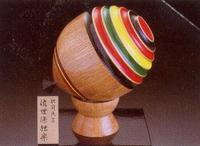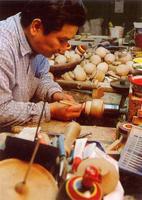

Total:131items
- Pottery & Porcelain (18)
- Lacquerware (4)
- Glasswork (2)
- Wood & Bamboo Work (19)
- Hakone Yosegi Zaiku: Hakone Marquetry
- Boshu Uchiwa: Boshu Fans
- Nikko-bori: Nikko carving
- Sasebo Koma (Sasebo Spinning Top)
- Shimoda Yanimatsu Zaiku (Shimoda Joinery of Oily Pine)
- Echizen Takeningyo (Bamboo Dolls)
- Osaka Senshu Kiri-dansu: Paulownia chest of drawers or wardrobes of Senshu, Osaka
- Kitayama Maruta: Japanese cedar logs
- Yodoegasa: Yodoe umbrella
- Atami Kusu Zaiku: Atami Camphor wood crafts
- Kawatsura Kokeshi Doll
- Itaya Zaiku: Itaya Bark Craft
- Yokohama Classic Furniture
- Hinaga Uchiwa: Hinaga Fan
- Torafu Takezaiku: Tiger Bamboo Work
- Tsuruzaiku: Woven Vine Craft
- Okawa Kumiko: Okawa Kumiko Wood Joinery
- Shuro Houki: Hemp-palm Broom
- Furyumen: Wood Carving Mask
- Leather Work (1)
- Papermaking (13)
- Textile (20)
- Dyeing products (5)
- Masonry (1)
- Metal Work (11)
- Stationery (4)
- Livingware (3)
- Accessory (4)
- Toys & Entertainment (14)
- Interior (2)
- Other crafts (10)

 |
Main Production Site:Nagasaki |
 《Characteristics》
《Characteristics》"Ikinaga shoumon shoukurabe." These words are a unique signal and indispensable to the participants as they shout when they spin the Sasebo spinning top all at once. It means not only to compete how long one can spin the spinning top but also "to give a signed and sealed deed and play a spinning top match." With the signal of "ikinaga shoumon shoukurabe" the spinning tops are spun all together and they are ranked first, second, third place, and so forth according to how long the spinning top can be spun. Especially, the first spinning top receives the honorary title "tenkaichi (best in the world)."
[Designated by the prefectural governor of Nagasaki prefecture as a traditional craft]
Source: Sasebo Koma Honpo
Translation by: Yoshiko Nagao, reviewed by Hiroko Okamura

| Materials | Matebashii tree |
|---|---|
| Crafting Processes | 1. Hard wood - Matebashii tree is mainly used
2. Dry thoroughly 3. Wood conversion - Cut the tree roughly 4. Rough finish - Decorticate the bark and shape to a round form 5. Finish the bottom - Shave the bottom part of the spinning top and polish 6. Add color 7. Finish the top - Shave the top part of the spinning top to a groove, polish the surface with bird's foot trefoil and straw 8. Color - Add color for finishing touch 9. Place "ken" or the point to the spinning top 10.Glaze - Varnish with a brush |
| History | Japanese spinning top was introduced before the Heian period (8-12c) by way of China and Korean Peninsula and mainly played by the imperial court as entertainment. During the period of the Northern and Southern Dynasties (14c), the spinning top matches were held throughout all of Japan. Hakata spinning top using an iron core was created around the time when Hideyoshi Toyotomi unified Japan. During the Edo period (17-19c), the Hakata spinning top rose in popularity throughout all of Japan and the gambling with the spinning top became so popular that the Shogunate had to issue bans many times. The general public was unable to obtain the Hakata spinning top as it was expensive and its production technique was difficult. Then, a spinning top with a wooden base and an iron core embedded began to be widely made throughout Japan. Presumably, the archetype of the Sasebo spinning top, which had been primitively created with a hatchet before, was created around this time.
The form of the Sasebo spinning top is called "rakkyo-gata (Japanese leek shape)" and the material is Fagacae's Matebashii tree which is a type of broad-leaved tree. The top part of the spinning top is applied with radiant color. The colors used were influenced by China's "Theory of Yin-Yang and the Five Elements."and were composed of five colors, blue (green), red, yellow, white (the color of fabric), and black. These five colors mean the world and universe. The point of the spinning top is embedded with a sharp iron called "ken." Sasebo was a small village with a population of 2,000 people at the Meiji period (19-20c), but grew to become a large city very fast. From the Meiji, Taisho, Showa, and to Heisei period (19-21c), the Sasebo spinning top continues to be played to this very day. In 1949 (Year 24 of Showa), when the Emperor Hirohito visited Sasebo, the spinning top was presented as a gift to him. With this the spinning top began to be produced not as a toy but as a traditional craft. Also in the same year, it was praised as a traditional craft representing Japan by the famous American designer Ms. Keller, who visited Japan invited by the Ministry of International Trade and Industry. Furthermore, it was selected as one of two toys that were exhibited in New York for the first time from Japan. This is how Sasebo spinning top became famous throughout Japan as well as in many countries and liked by many tourists as a traditional craft item of Sasebo. |
| Related URL | http://sasebokoma.jp/ |
◆Exhibition / Showcase
Sasebo Koma Honpo
(The Sasebo Koma is on exhibition and on sale. Visitors can see the production process.)
Place: 9-13 Shimanji-cho, Sasebo-shi, Nagasaki prefecture, 857-0879
Access: 10 minute walk (in the direction of Commander Fleet Activities Sasebo) from JR Sasebo Station on the Sasebo Line
Opening hours: 9:30a.m. ~19:00p.m.
Days off: Irregular



